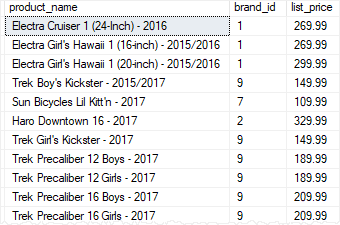Summary: in this tutorial, you will learn about the SQL Server table variables that hold rows of data.
What are table variables
Table variables are kinds of variables that allow you to hold rows of data, which are similar to temporary tables.
How to declare table variables
To declare a table variable, you use the DECLARE statement as follows:
DECLARE @table_variable_name TABLE (
column_list
);
Code language: SQL (Structured Query Language) (sql)In this syntax, you specify the name of the table variable between the DECLARE and TABLE keywords. The name of the table variables must start with the @ symbol.
Following the TABLE keyword, you define the structure of the table variable which is similar to the structure of a regular table that includes column definitions, data type, size, optional constraint, etc.
The scope of table variables
Similar to local variables, table variables are out of scope at the end of the batch.
If you define a table variable in a stored procedure or user-defined function, the table variable will no longer exist after the stored procedure or user-defined function exits.
Table variable example
For example, the following statement declares a table variable named @product_table which consists of three columns: product_name, brand_id, and list_price:
DECLARE @product_table TABLE (
product_name VARCHAR(MAX) NOT NULL,
brand_id INT NOT NULL,
list_price DEC(11,2) NOT NULL
);
Code language: SQL (Structured Query Language) (sql)Inserting data into the table variables
Once declared, the table variable is empty. You can insert rows into the table variables using the INSERT statement:
INSERT INTO @product_table
SELECT
product_name,
brand_id,
list_price
FROM
production.products
WHERE
category_id = 1;
Code language: SQL (Structured Query Language) (sql)Querying data from the table variables
Similar to a temporary table, you can query data from the table variables using the SELECT statement:
SELECT
*
FROM
@product_table;
Code language: SQL (Structured Query Language) (sql)Note that you need to execute the whole batch or you will get an error:
DECLARE @product_table TABLE (
product_name VARCHAR(MAX) NOT NULL,
brand_id INT NOT NULL,
list_price DEC(11,2) NOT NULL
);
INSERT INTO @product_table
SELECT
product_name,
brand_id,
list_price
FROM
production.products
WHERE
category_id = 1;
SELECT
*
FROM
@product_table;
GOCode language: SQL (Structured Query Language) (sql)The following picture shows the partial output:

Restrictions on table variables
First, you have to define the structure of the table variable during the declaration. Unlike a regular or temporary table, you cannot alter the structure of the table variables after they are declared.
Second, statistics help the query optimizer to come up with a good query’s execution plan. Unfortunately, table variables do not contain statistics. Therefore, you should use table variables to hold a small number of rows.
Third, you cannot use the table variable as an input or output parameter like other data types. However, you can return a table variable from a user-defined function
Fourth, you cannot create non-clustered indexes for table variables. However, starting with SQL Server 2014, memory-optimized table variables are available with the introduction of the new In-Memory OLTP that allows you to add non-clustered indexes as part of table variable’s declaration.
Fifth, if you are using a table variable with a join, you need to alias the table in order to execute the query. For example:
SELECT
brand_name,
product_name,
list_price
FROM
brands b
INNER JOIN @product_table pt
ON p.brand_id = pt.brand_id;
Code language: SQL (Structured Query Language) (sql)Performance of table variables
Using table variables in a stored procedure results in fewer recompilations than using a temporary table.
In addition, a table variable use fewer resources than a temporary table with less locking and logging overhead.
Similar to the temporary table, the table variables do live in the tempdb database, not in the memory.
Using table variables in user-defined functions
The following user-defined function named ufnSplit() that returns a table variable.
CREATE OR ALTER FUNCTION udfSplit(
@string VARCHAR(MAX),
@delimiter VARCHAR(50) = ' ')
RETURNS @parts TABLE
(
idx INT IDENTITY PRIMARY KEY,
val VARCHAR(MAX)
)
AS
BEGIN
DECLARE @index INT = -1;
WHILE (LEN(@string) > 0)
BEGIN
SET @index = CHARINDEX(@delimiter , @string) ;
IF (@index = 0) AND (LEN(@string) > 0)
BEGIN
INSERT INTO @parts
VALUES (@string);
BREAK
END
IF (@index > 1)
BEGIN
INSERT INTO @parts
VALUES (LEFT(@string, @index - 1));
SET @string = RIGHT(@string, (LEN(@string) - @index));
END
ELSE
SET @string = RIGHT(@string, (LEN(@string) - @index));
END
RETURN
END
GO
Code language: SQL (Structured Query Language) (sql)The following statement calls the udfSplit() function:
SELECT
*
FROM
udfSplit('foo,bar,baz',',');
Code language: SQL (Structured Query Language) (sql)Here is the output:

In this tutorial, you will learn how to use the SQL Server table variables which offer some performance benefits and flexibility in comparison with temporary tables.